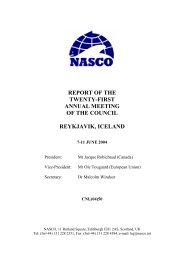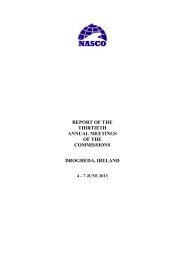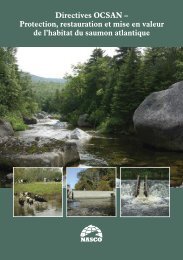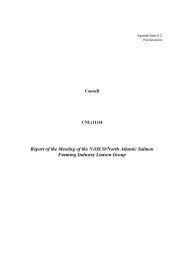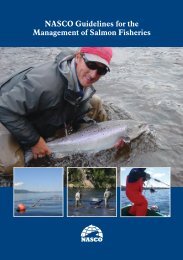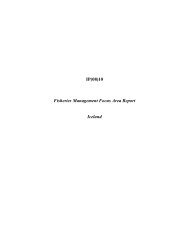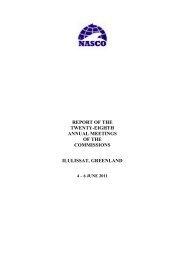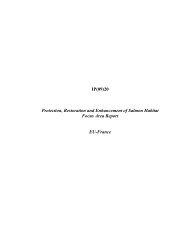Report of the 2005 ICES/NASCO Symposium on Interactions ...
Report of the 2005 ICES/NASCO Symposium on Interactions ...
Report of the 2005 ICES/NASCO Symposium on Interactions ...
You also want an ePaper? Increase the reach of your titles
YUMPU automatically turns print PDFs into web optimized ePapers that Google loves.
NINA SPECIAL REPORT 34<br />
Atlantic and Canada’s Pacific Coast. While significant<br />
challenges to analysis <str<strong>on</strong>g>of</str<strong>on</strong>g> this data include a high degree <str<strong>on</strong>g>of</str<strong>on</strong>g><br />
natural variati<strong>on</strong>, missing data, and variati<strong>on</strong> in data quality,<br />
this approach allows for direct estimati<strong>on</strong> <str<strong>on</strong>g>of</str<strong>on</strong>g> impacts <strong>on</strong><br />
natural populati<strong>on</strong>s.<br />
Temporal genetic stability in Atlantic salm<strong>on</strong><br />
populati<strong>on</strong>s<br />
Øystein Skaala, Vidar Wennevik and Kevin A Glover<br />
Every year, farmed salm<strong>on</strong> escape from sea cages and<br />
hatcheries in high numbers. Selecti<strong>on</strong> programmes and<br />
domesticati<strong>on</strong> have changed <str<strong>on</strong>g>the</str<strong>on</strong>g>ir genetic compositi<strong>on</strong> to<br />
perform better in <str<strong>on</strong>g>the</str<strong>on</strong>g> cultured envir<strong>on</strong>ment, and possibly<br />
worse in natural envir<strong>on</strong>ments. Therefore, immigrati<strong>on</strong> <str<strong>on</strong>g>of</str<strong>on</strong>g><br />
high numbers <str<strong>on</strong>g>of</str<strong>on</strong>g> escaped farmed salm<strong>on</strong> in natural salm<strong>on</strong><br />
stocks may potentially alter <str<strong>on</strong>g>the</str<strong>on</strong>g> genetic traits and cause<br />
fitness changes in wild salm<strong>on</strong>. To investigate <str<strong>on</strong>g>the</str<strong>on</strong>g> temporal<br />
stability in a number <str<strong>on</strong>g>of</str<strong>on</strong>g> wild Norwegian salm<strong>on</strong> stocks,<br />
genetic pr<str<strong>on</strong>g>of</str<strong>on</strong>g>iles were produced from historical scale<br />
samples and more recently collected scale material.<br />
Salm<strong>on</strong> from Rivers Namsen, Etne, Opo,Vosso, Granvin,<br />
Eio and Håelva were genotyped at <str<strong>on</strong>g>the</str<strong>on</strong>g> following<br />
microsatellite loci: Ssa13.37, Ssa28, SsOSL85, Ssa197,<br />
Ssa20.19, SsaF43, Ssa202, Ssa85, Ssa171, SsOSL417 and<br />
SsOSL438. In Rivers Namsen and Etne no changes were<br />
observed in DNA pr<str<strong>on</strong>g>of</str<strong>on</strong>g>iles between historical and new<br />
samples. In River Vosso genetic stability was observed<br />
between historical baseline and spawners up to 1997,<br />
while a significant change was observed in later year<br />
classes. This change corresp<strong>on</strong>ds in time to year classes<br />
spawned after high immigrati<strong>on</strong> <str<strong>on</strong>g>of</str<strong>on</strong>g> farmed salm<strong>on</strong>. A<br />
significant change in genetic pr<str<strong>on</strong>g>of</str<strong>on</strong>g>iles over time was also<br />
observed in River Opo. A reducti<strong>on</strong> in Fst values over<br />
time was observed, indicating reduced level <str<strong>on</strong>g>of</str<strong>on</strong>g> populati<strong>on</strong><br />
differentiati<strong>on</strong>.<br />
Pros and c<strong>on</strong>s <str<strong>on</strong>g>of</str<strong>on</strong>g> using sterile salm<strong>on</strong> in<br />
aquaculture<br />
Tillmann Benfey<br />
Sterile populati<strong>on</strong>s are useful for <str<strong>on</strong>g>the</str<strong>on</strong>g> preventi<strong>on</strong> <str<strong>on</strong>g>of</str<strong>on</strong>g><br />
spawning <str<strong>on</strong>g>of</str<strong>on</strong>g> escaped farmed fish in <str<strong>on</strong>g>the</str<strong>on</strong>g> wild, <str<strong>on</strong>g>the</str<strong>on</strong>g><br />
eliminati<strong>on</strong> <str<strong>on</strong>g>of</str<strong>on</strong>g> farm producti<strong>on</strong> losses associated with early<br />
maturati<strong>on</strong> and/or <str<strong>on</strong>g>the</str<strong>on</strong>g> protecti<strong>on</strong> <str<strong>on</strong>g>of</str<strong>on</strong>g> investments made in<br />
developing novel genotypes. Given <str<strong>on</strong>g>the</str<strong>on</strong>g> generally reduced<br />
performance <str<strong>on</strong>g>of</str<strong>on</strong>g> sterile fish in aquaculture to date, <str<strong>on</strong>g>the</str<strong>on</strong>g> true<br />
need for sterile populati<strong>on</strong>s should be assessed <strong>on</strong> a caseby-case<br />
basis prior to <str<strong>on</strong>g>the</str<strong>on</strong>g>ir large-scale use for commercial<br />
producti<strong>on</strong>. This paper briefly summarizes <str<strong>on</strong>g>the</str<strong>on</strong>g> opti<strong>on</strong>s<br />
available for rendering fish reproductively sterile, and <str<strong>on</strong>g>the</str<strong>on</strong>g>n<br />
32<br />
focuses <strong>on</strong> <str<strong>on</strong>g>the</str<strong>on</strong>g> pros and c<strong>on</strong>s <str<strong>on</strong>g>of</str<strong>on</strong>g> using all-female triploid<br />
populati<strong>on</strong>s <str<strong>on</strong>g>of</str<strong>on</strong>g> Atlantic salm<strong>on</strong> for aquaculture. The mass<br />
producti<strong>on</strong> <str<strong>on</strong>g>of</str<strong>on</strong>g> all-female triploid populati<strong>on</strong>s is easy and<br />
inexpensive to achieve, although <str<strong>on</strong>g>the</str<strong>on</strong>g>re are some logistical<br />
c<strong>on</strong>straints with respect to broodstock requirements.<br />
Maximizing <str<strong>on</strong>g>the</str<strong>on</strong>g> performance <str<strong>on</strong>g>of</str<strong>on</strong>g> triploid fish requires a<br />
clear understanding <str<strong>on</strong>g>of</str<strong>on</strong>g> <str<strong>on</strong>g>the</str<strong>on</strong>g>ir unique biology as well as a<br />
l<strong>on</strong>g-term commitment to selective breeding based <strong>on</strong><br />
triploid producti<strong>on</strong> characteristics. As yet, nei<str<strong>on</strong>g>the</str<strong>on</strong>g>r <str<strong>on</strong>g>of</str<strong>on</strong>g> <str<strong>on</strong>g>the</str<strong>on</strong>g>se<br />
issues has been adequately addressed through commercial<br />
culture; until this is d<strong>on</strong>e, <str<strong>on</strong>g>the</str<strong>on</strong>g> true advantages (and<br />
disadvantages) <str<strong>on</strong>g>of</str<strong>on</strong>g> sterile salm<strong>on</strong> cannot be known.<br />
Development in cage technology designed to<br />
minimize escapes from salm<strong>on</strong> farms<br />
Arne Fredheim<br />
Escape <str<strong>on</strong>g>of</str<strong>on</strong>g> fish from fish farms is <strong>on</strong>e <str<strong>on</strong>g>of</str<strong>on</strong>g> <str<strong>on</strong>g>the</str<strong>on</strong>g> major<br />
envir<strong>on</strong>mental impacts caused by modern fish farming.<br />
Reducti<strong>on</strong> <str<strong>on</strong>g>of</str<strong>on</strong>g> <str<strong>on</strong>g>the</str<strong>on</strong>g> number <str<strong>on</strong>g>of</str<strong>on</strong>g> escapees has been a major<br />
objective for <str<strong>on</strong>g>the</str<strong>on</strong>g> Norwegian fish farming industry in<br />
recent years. The l<strong>on</strong>g-term aim is to reduce <str<strong>on</strong>g>the</str<strong>on</strong>g> extent<br />
<str<strong>on</strong>g>of</str<strong>on</strong>g> escapes to a level where <str<strong>on</strong>g>the</str<strong>on</strong>g>y do not pose a threat to<br />
<str<strong>on</strong>g>the</str<strong>on</strong>g> wild salm<strong>on</strong>. The focus <strong>on</strong> reducing escapes has<br />
resulted in <str<strong>on</strong>g>the</str<strong>on</strong>g> development <str<strong>on</strong>g>of</str<strong>on</strong>g> technical requirements for<br />
floating fish farms. Improvement to operati<strong>on</strong>s and<br />
handling <str<strong>on</strong>g>of</str<strong>on</strong>g> equipment and fish to prevent accidents has<br />
also been c<strong>on</strong>sidered important. New fish farms have to<br />
be certified according to technical requirements and to<br />
prove <str<strong>on</strong>g>the</str<strong>on</strong>g>y have <str<strong>on</strong>g>the</str<strong>on</strong>g> necessary strength to withstand<br />
envir<strong>on</strong>mental c<strong>on</strong>diti<strong>on</strong>s at <str<strong>on</strong>g>the</str<strong>on</strong>g> particular locati<strong>on</strong>.<br />
Included in <str<strong>on</strong>g>the</str<strong>on</strong>g> requirements are user manuals developed<br />
by <str<strong>on</strong>g>the</str<strong>on</strong>g> equipment manufacturers for mounting, handling,<br />
operating and maintaining <str<strong>on</strong>g>of</str<strong>on</strong>g> all equipment. To fur<str<strong>on</strong>g>the</str<strong>on</strong>g>r<br />
minimize escapes from fish farms, cage design needs to<br />
focus both <strong>on</strong> reducing probability and c<strong>on</strong>sequences <str<strong>on</strong>g>of</str<strong>on</strong>g><br />
accidents both with regard to technical failure and<br />
incidents and to reduce <str<strong>on</strong>g>the</str<strong>on</strong>g> possibility and c<strong>on</strong>sequence<br />
<str<strong>on</strong>g>of</str<strong>on</strong>g> incorrect use and operati<strong>on</strong> <str<strong>on</strong>g>of</str<strong>on</strong>g> equipment. Based <strong>on</strong><br />
such aspects, new net cage designs and improved mooring<br />
systems have been developed.<br />
C<strong>on</strong>flicts between diadromous fish<br />
restorati<strong>on</strong> programmes (e.g. shad, striped<br />
bass) and c<strong>on</strong>servati<strong>on</strong> <str<strong>on</strong>g>of</str<strong>on</strong>g> populati<strong>on</strong>s <str<strong>on</strong>g>of</str<strong>on</strong>g><br />
Atlantic salm<strong>on</strong><br />
Douglas Grout<br />
Anadromous populati<strong>on</strong>s <str<strong>on</strong>g>of</str<strong>on</strong>g> striped bass (Mor<strong>on</strong>e saxatilis)<br />
are found al<strong>on</strong>g <str<strong>on</strong>g>the</str<strong>on</strong>g> Atlantic coast <str<strong>on</strong>g>of</str<strong>on</strong>g> North America from<br />
Maine to North Carolina. Recruitment overfishing



